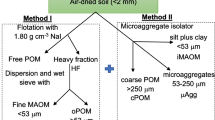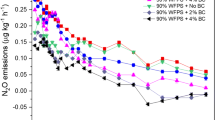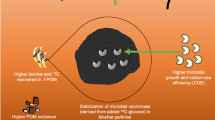Abstract
Biochar as a soil ameliorant has generated great interest for scientists in improving soil quality and carbon sequestration. The objective of this study was to investigate the persistent effects of biochar application on soil organic carbon (SOC) mineralization and soil-resistant carbon (Cr) in upland red soil. This experiment was conducted from September 2011 to May 2016. Biochar was applied only once in September 2011 at rates of 0, 2.5, 5, 10, 20, 30 and 40 t/ha in the field experiment, designated as treatments B0, B1, B2, B3, B4, B5 and B6. The chemical properties, dynamics of SOC mineralization and soil-resistant carbon (Cr) were measured at the 1st and 6th year after biochar application. The results were as follows: biochar application at rates of 30 and 40 t/ha (B5 and B6 treatments) distinctly increased soil pH value and available P relative to B0 in 2011. The pH value, available P, SOC, total N and C/N ratio in B4, B5 and B6 treatments were significantly higher compared with the B0 treatment, where the B6 treatment increased the pH value by 0.80 and C/N ratio by 3.88 while increasing available P, SOC and total N by 24.18, 76.29 and 19.78%, respectively, compared with the B0 treatment in 2016. The cumulative SOC mineralization (Cm) occupied around 4.62–6.91% of total organic carbon (Ct), which showed a declining trend in 2016 as compared to 2011. The Cm/Ct ratio also showed a declining trend with biochar amendment at both samplings. The Cr occupied around 26–46% of SOC and showed obviously increasing trends both in 2011 and 2016. We further found that Cm/Ct showed highly significant (p < 0.01) negative correlations with the rates of biochar application both in 2011 and 2016. The Cr, however, showed very significant (p < 0.01) positive correlations with the rates of biochar application both in 2011 and 2016. This study suggested that biochar application to upland red soil persistently improved soil properties and resistant carbon. Cumulative SOC mineralization was clearly restrained by biochar amendment. This study can provide scientific support for improving soil fertility and enhancing carbon sequestration by application of large amount of biochar (40 t/ha) in upland red soil.

Similar content being viewed by others
References
Ameloot N, Graber ER, Verheijen FG, De Neve S (2013) Interactions between biochar stability and soil organisms: review and research needs. Eur J Soil Sci 64(4):379–390
Bao SD (2000) Analysis of agrochemistry, 3rd edn. China Agricultural Press, Bejing, pp 25–89
Batjes NH (2014) Total carbon and nitrogen in the soils of the world. Eur J Soil Sci 47(1):151–163
Bengtsson G, Bengtson P, Mansson KF (2003) Gross nitrogen mineralization, immobilisation, and nitrification rates as a function of soil C/N ratio and microbial activity. Soil Biol Biochem 35(1):143–154
Borken W, Matzner E (2009) Reappraisal of drying and wetting effects on C and N mineralization and fluxes in soils. Glob Change Biol 15(4):808–824
Case SDC, McNamara NP, Reay DS, Whitaker J (2012) The effect of biochar addition on N2O and CO2 emissions from a sandy loam soil—the role of soil aeration. Soil Biol Biochem 51(3):125–134
Change IPOC (2007) Climate change 2007: the physical science basis. Agenda 6(07):333
Chen JY, Sun B, Li ZP, Li HY, Pan JJ (2008a) Pool size of soil organic carbon and dynamics under different land use. J Soil Water Conserv 22(1):91–95 (in Chinese)
Chen T, Hao XJ, Du LJ, Lin S, Feng M, Hu RG (2008b) Effect of long-term different fertilizations on organic carbon mineralization in paddy soil. Chin J Appl Ecol 19(7):1494–1500 (in Chinese)
Chen C, Chen D, Lam SK (2015) Simulation of nitrous oxide emission and mineralized nitrogen under different straw retention conditions using a denitrification–decomposition model. Clean Soil Air Water 43(4):577–583
Dempster DN, Gleeson DB, Solaiman ZM, Jones DL, Murphy DV (2012) Decreased soil microbial biomass and nitrogen mineralization with eucalyptus biochar addition to a coarse textured soil. Plant Soil 354(1):311–324
Forbes MS, Raison RJ, Skjemstad JO (2006) Formation, transformation and transport of black carbon (charcoal) in terrestrial and aquatic ecosystems. Sci Total Environ 370(1):190–206
Fowles M (2007) Black carbon sequestration as an alternative to bioenergy. Biomass Bioenergy 31(6):426–432
Freddo A, Cai C, Reid BJ (2012) Environmental contextualisation of potential toxic elements and polycyclic aromatic hydrocarbons in biochar. Environ Pollut 171(4):18–24
Freixo AA, Machado PL, Santos HP (2002) Soil organic carbon and fractions of a rhodic ferralsol under the influence of tillage and crop rotation systems in Southern Brazil. Soil Tillage Res 64(3–4):221–230
Gaskin JW, Speir RA, Harris K, Das KC, Lee RD, Morris LA, Fisher DS (2010) Effect of peanut hull and pine chip biochar on soil nutrients, corn nutrient status, and yield. Agron J 102(2):623–633
Glaser B, Lehmann J, Zech W (2002) Ameliorating physical and chemical properties of highly weathered soils in the tropics with charcoal—a review. Biol Fertil Soils 35(4):219–230
Grace J (2004) Understanding and managing the global carbon cycle. J Ecol 92(2):189–202
Haefele SM, Konboon Y, Wongboon W, Amarante S, Maarifat AA, Pfeiffer EM, Knoblauch C (2011) Effects and fate of biochar from rice residues in rice-based systems. Field Crop Res 121(3):430–440
Jeffery S, Verheijen FG, Velde MV, Bastos AC (2011) A quantitative review of the effects of biochar application to soils on crop productivity using meta-analysis. Agric Ecosyst Environ 144(1):175–187
Kasozi GN, Zimmerman AR, Nkedi-Kizza P, Gao B (2010) Catechol and humic acid sorption onto a range of laboratory-produced black carbons (biochars). Environ Sci Technol 44(16):6189–6195
Keith A, Singh B, Singh BP (2011) Interactive priming of biochar and labile organic matter mineralization in a smectite-rich soil. Environ Sci Technol 45(22):9611–9618
Kuzyakov Y, Subbotina I, Chen HQ, Bogomolova I, Xu XL (2009) Black carbon decomposition and incorporation into soil microbial biomass estimated by 14C labeling. Soil Biol Biochem 41(2):210–219
Lehmann J (2007) A handful of carbon. Nature 447(7141):143–144
Lehmann J, Gaunt J, Rondon M (2006) Bio-char sequestration in terrestrial ecosystems—a review. Mitig Adapt Strat Glob Change 11:403–427
Lentz RD, Ippolito JA (2012) Biochar and manure affect calcareous soil and corn silage nutrient concentrations and uptake. J Environ Qual 41:1033–1043
Li XM, Shen QR, Zhang DQ, Mei XL, Ran W, Xu YC, Yu GH (2013) Functional groups determine biochar properties (pH and EC) as studied by two-dimensional C-13 NMR correlation spectroscopy. PLoS ONE 8:e65949
Liang B, Lehmann J, Sohi SP, Thies JE, O’Neill B, Trujillo L, Luizão FJ (2010) Black carbon affects the cycling of non-black carbon in soil. Org Geochem 41:206–213
Lin Y, Munroe P, Joseph S, Kimber S, Van Zwieten L (2012) Nanoscale organo-mineral reactions of biochars in ferrosol: an investigation using microscopy. Plant Soil 357:369–380
Liu X, Zhang A, Ji C, Joseph S, Bian R, Li L, Paz-Ferreiro J (2013) Biochar’s effect on crop productivity and the dependence on experimental conditions—a meta-analysis of literature data. Plant Soil 373:583–594
Liu ZX, Chen XM, Jing Y, Li QX, Zhang JB, Huang QR (2014) Effects of biochar amendment on rapeseed and sweet potato yields and water stable aggregate in upland red soil. CATENA 123:45–51
Liu S, Zhang Y, Zong Y, Hu Z, Wu S, Zhou J, Zou J (2016) Response of soil carbon dioxide fluxes, soil organic carbon and microbial biomass carbon to biochar amendment: a meta-analysis. GCB Bioenergy 8:392–406
Luo Y, Durenkamp M, De Nobili M, Lin Q, Brookes PC (2011) Short term soil priming effects and the mineralisation of biochar following its incorporation to soils of different pH. Soil Biol Biochem 43:2304–2314
Luo X, Wang L, Liu G, Wang X, Wang Z, Zheng H (2016) Effects of biochar on carbon mineralization of coastal wetland soils in the Yellow River Delta, China. Ecol Eng 94:329–336
Lützow M, Leifeld J, Kainz M, Kogel-Knabner I, Munch JC (2002) Indications for soil organic matter quality in soils under different management. Geoderma 105:243–258
Major J, Rondon M, Molina D, Riha SJ, Lehmann J (2010) Maize yield and nutrition during 4 years after biochar application to a Colombia savanna oxisol. Plant Soil 333:117–128
Mathews JA (2008) Carbon-negative biofuels. Energy Policy 36:940–945
McHenry MP (2008) Agricultural biochar production, renewable energy generation and farm carbon sequestration in Western Australia: certainty, uncertainty and risk. Agric Ecosyst Environ 129:1–7
Oguntunde PG, Fosu M, Ajayi AE, Giesen N (2004) Effects of charcoal production on maize yield, chemical properties and texture of soil. Biol Fertil Soils 39:295–299
Pan GX, Lin ZH, Li LQ (2011) Perspective on biomass carbon industrialization of organic waste from agriculture and rural areas in China. J Agric Sci Technol 13(1):75–82 (in Chinese)
Parton WJ, Stewart JWB, Cole CV (1988) Dynamics of C, N, P and S in grassland soils: a model. Biogeochemistry 5:109–131
Rogovska N, Laird D, Cruse R, Fleming P, Parkin T, Meek D (2011) Impact of biochar on manure carbon stabilization and greenhouse gas emissions. Soil Sci Soc Am J 75:871–879
Scott DS, Jan P (1984) The continuous flash pyrolysis of biomass. Can J Chem Eng 62:404–412
Singh BP, Cowie AL (2014) Long-term influence of biochar on native organic carbon mineralisation in a low-carbon clayey soil. Sci Rep 4:3687
Smith JL, Collins HP, Bailey VL (2010) The effect of young biochar on soil respiration. Soil Biol Biochem 42:2345–2347
Spokas KA, Reicosky DC (2009) Impacts of sixteen different biochars on soil greenhouse gas production. Ann Environ Sci 3:179–193
Steinbeiss S, Gleixner G, Antonietti M (2009) Effect of biochar amendment on soil carbon balance and soil microbial activity. Soil Biol Biochem 6:1301–1310
Tenenbaum DJ (2009) Carbon mitigation from the ground up. Environ Health Persp 117:A70–A73
Van Zwieten L, Kimber S, Downie A, Morris S, Petty S, Rust J, Chan KY (2010) A glasshouse study on the interaction of low mineral ash biochar with nitrogen in a sandy soil. Soil research 48:569–576
Wang JY, Zhang M, Xiong ZQ, Liu PL, Pan GX (2011) Effects of biochar addition on N2O and CO2 emissions from two paddy soils. Biol Fertil Soils 47:887–896
Woolf D, Lehmann J (2012) Modelling the long-term response positive and negative priming of soil organic carbon by black carbon. Biogeochemistry 111:83–95
Xiao M, Dong S, Li Z, Tang X, Chen Y, Yang S, Wu C, Ouyang D, Fang C, Song Z (2015) Effects of water management practices on residue decomposition and degradation of Cry1Ac protein from crop-wild Bt rice hybrids and parental lines during winter fallow season. Ecotox Environ Safe 122(2):275
Xu R, Zhao A, Li Q, Kong X, Ji G (2003) Acidity regime of the red soils in a subtropical region of southern china under field conditions. Geoderma 115:75–84
Yan YP, Cao J, Yang H, Yin H, Liang Y, Wang P (2012) The impact of different soil types on soil organic carbon pool and turnover in Karst Area. J Soil Water Conserv 26(2):144–149 (in Chinese)
Yuan JH, Xu RK, Wang N, Li JY (2011) Amendment of acid soils with crop residues and biochars. Pedosphere 21:302–308
Zhang AF, Liu YM, Pan GX, Hussain Q, Li LQ, Zheng JW, Zhang XH (2012) Effect of biochar amendment on maize yield and greenhouse gas emissions from a soil organic carbon poor calcareous loamy soil from central China Plain. Plant Soil 351:263–275
Zhang XL, Chen XM, Tao PC, Jin ZW, Han ZQ, Chen C (2017) Effect of biochar on soil organic carbon mineralization and carbon pool in upland red soil. J Soil Water Conservation 31:192–196 (in Chinese)
Zimmerman AR, Gao B, Ahn MY (2011) Positive and negative carbon mineralization priming effects among a variety of biochar-amended soils. Soil Biol Biochem 43:1169–1179
Acknowledgements
The authors thank Dr. Christopher Ogden (formerly of Cornell Medical College in Qatar) for his check of English and comments on this paper. This work was supported by National Key R&D Program (2016 YFD 0200305), the Natural Science Foundation of Jiangsu Province, China (No. SBK 2015040286), and a project funded by the Priority Academic Program Development of Jiangsu Higher Education Institutions (PAPD).
Author information
Authors and Affiliations
Corresponding author
Rights and permissions
About this article
Cite this article
Zhang, X., Chen, C., Chen, X. et al. Persistent effects of biochar on soil organic carbon mineralization and resistant carbon pool in upland red soil, China. Environ Earth Sci 77, 177 (2018). https://doi.org/10.1007/s12665-018-7359-9
Received:
Accepted:
Published:
DOI: https://doi.org/10.1007/s12665-018-7359-9




